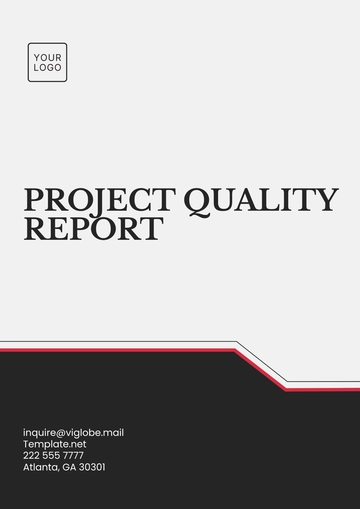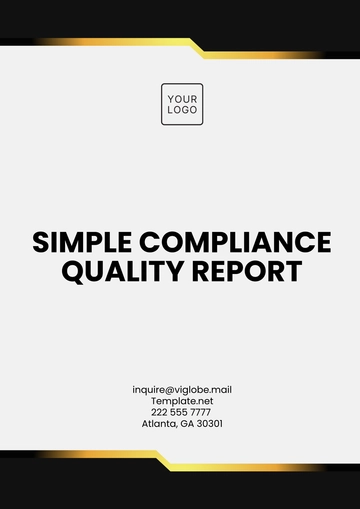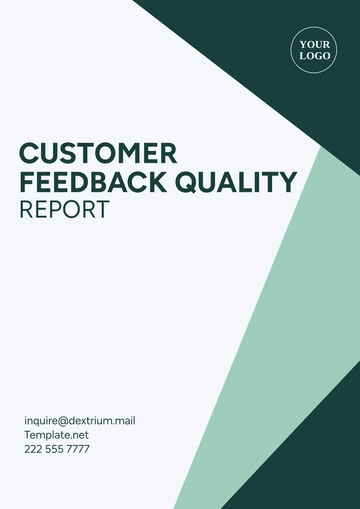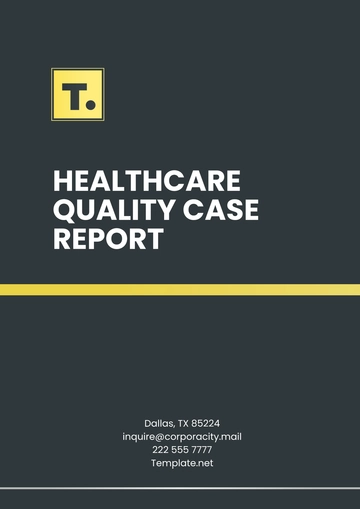Free Quality Report

Introduction
The Quality Report for the year 2056 aims to provide a comprehensive overview of the advancements, challenges, and strategies concerning quality assurance across various sectors. As industries evolve with technological advancements, the definition and scope of quality have also transformed. This report delves into the multi-dimensional aspects of quality required to meet the futuristic demands of diverse stakeholders.
Technological Advancements
Artificial Intelligence and Automation
Artificial intelligence (AI) and automation have revolutionized quality control processes in manufacturing and service industries. By 2056, AI-driven systems are expected to perform real-time quality checks, reducing human intervention and error. Automated workflows enhance precision and speed, ensuring higher consistency in product and service quality.
Blockchain Technology
Blockchain offers a secure and transparent method for tracking product life cycles. Its integration in supply chain management has enhanced traceability and accountability, allowing stakeholders to verify authenticity and compliance with quality standards. By 2056, it is projected that blockchain integration will be commonplace across industries.
Challenges in Quality Assurance
Dynamic Consumer Expectations
The modern consumer in 2056 is more informed, with expectations continuously shaped by global trends and technological innovations. Companies must adopt agile methodologies to anticipate and meet changing consumer demands, ensuring product relevance and satisfaction.
Environmental Sustainability
As environmental concerns continue to gain prominence, quality assurance practices must align with sustainable development goals. By 2056, industries are expected to innovate in material use, waste reduction, and energy efficiency, incorporating these aspects into their quality benchmarks.
Quality Standards Across Industries
Manufacturing
Industry | Standard | Overview |
|---|---|---|
Automotive | ISO 9001:2056 | Focuses on sustainability and integrated AI diagnostics for consistent quality management. |
Electronics | IEC QMS 2056 | Emphasizes on-life cycle tracking with blockchain and automated QA processes. |
Healthcare
In 2056, healthcare quality standards are deeply interwoven with technology, focusing on patient-centric care. Advances in telehealth and personalized medicine demand that quality measures reflect emerging ethical and privacy concerns, apart from traditional medical efficacy metrics.
Strategies for Future Quality Assurance
Continuous Improvement and Innovation
Encourage investment in research and development to pioneer new quality assurance methods.
Adopt agile frameworks that support quick adaptation to technological changes and consumer needs.
Utilize data analytics to predict quality trends and proactively address potential issues.
Collaboration and Knowledge Sharing
Foster industry collaborations to share best practices and develop unified quality standards.
Promote open access to quality improvement resources and training.
Engage with educational institutions to integrate quality management into curricula.
Conclusion
The landscape of quality assurance by 2056 is expected to be vastly different from today, driven by technological advancements, evolving consumer expectations, and a growing commitment to sustainability. To maintain competitive advantage, organizations must not only adapt to these changes but also anticipate future trends, integrating them into their quality strategies. This proactive approach will ensure the delivery of superior-quality products and services, catering to a diverse and dynamic market.
- 100% Customizable, free editor
- Access 1 Million+ Templates, photo’s & graphics
- Download or share as a template
- Click and replace photos, graphics, text, backgrounds
- Resize, crop, AI write & more
- Access advanced editor
Enhance your reporting process with the Quality Report Template, offered by Template.net. This professionally designed, customizable document is perfect for showcasing performance insights with clarity. Fully downloadable, printable, and editable in our AI Editor Tool, it provides flexibility and ease for your quality management needs. Streamline your workflow with this versatile template today!
You may also like
- Sales Report
- Daily Report
- Project Report
- Business Report
- Weekly Report
- Incident Report
- Annual Report
- Report Layout
- Report Design
- Progress Report
- Marketing Report
- Company Report
- Monthly Report
- Audit Report
- Status Report
- School Report
- Reports Hr
- Management Report
- Project Status Report
- Handover Report
- Health And Safety Report
- Restaurant Report
- Construction Report
- Research Report
- Evaluation Report
- Investigation Report
- Employee Report
- Advertising Report
- Weekly Status Report
- Project Management Report
- Finance Report
- Service Report
- Technical Report
- Meeting Report
- Quarterly Report
- Inspection Report
- Medical Report
- Test Report
- Summary Report
- Inventory Report
- Valuation Report
- Operations Report
- Payroll Report
- Training Report
- Job Report
- Case Report
- Performance Report
- Board Report
- Internal Audit Report
- Student Report
- Monthly Management Report
- Small Business Report
- Accident Report
- Call Center Report
- Activity Report
- IT and Software Report
- Internship Report
- Visit Report
- Product Report
- Book Report
- Property Report
- Recruitment Report
- University Report
- Event Report
- SEO Report
- Conference Report
- Narrative Report
- Nursing Home Report
- Preschool Report
- Call Report
- Customer Report
- Employee Incident Report
- Accomplishment Report
- Social Media Report
- Work From Home Report
- Security Report
- Damage Report
- Quality Report
- Internal Report
- Nurse Report
- Real Estate Report
- Hotel Report
- Equipment Report
- Credit Report
- Field Report
- Non Profit Report
- Maintenance Report
- News Report
- Survey Report
- Executive Report
- Law Firm Report
- Advertising Agency Report
- Interior Design Report
- Travel Agency Report
- Stock Report
- Salon Report
- Bug Report
- Workplace Report
- Action Report
- Investor Report
- Cleaning Services Report
- Consulting Report
- Freelancer Report
- Site Visit Report
- Trip Report
- Classroom Observation Report
- Vehicle Report
- Final Report
- Software Report





























